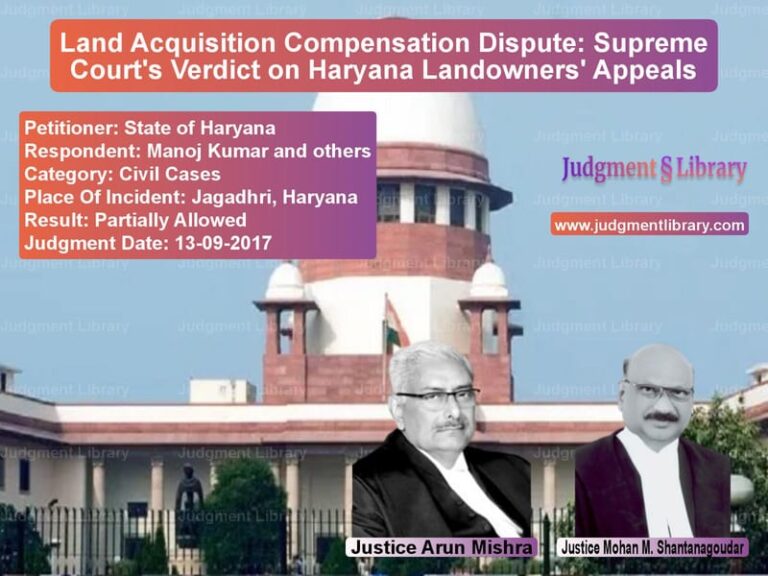Murder Conviction Upheld: Supreme Court Reaffirms Section 106 of Evidence Act in Domestic Homicide Case
The Supreme Court, in the case of Anees v. The State Govt. of NCT, delivered a significant ruling that reinforces the role of circumstantial evidence and the application of Section 106 of the Indian Evidence Act in cases where the accused has exclusive knowledge of the crime. The case involves the brutal murder of the appellant’s wife within the confines of their home, with the prosecution relying on the last-seen theory, forensic evidence, and the conduct of the accused.
Background of the Case
The tragic incident occurred on December 29, 1995, in Mustafabad, Delhi. The appellant, Anees, was accused of stabbing his wife, Saira, multiple times in their home. The police received information about a violent altercation, and upon arrival, found Saira lying in a pool of blood. The appellant was present at the scene, with his clothes stained with blood. He was immediately taken into custody, and the knife allegedly used in the murder was later recovered based on his statement.
Prosecution’s Arguments
- The appellant had ongoing disputes with his wife over her late-night outings, indicating a history of domestic strife.
- Their minor daughter, Shaheena, was the sole eyewitness but later turned hostile.
- The appellant was found at the crime scene, and forensic analysis confirmed that the blood on his clothes matched the victim’s.
- The murder weapon, a knife, was recovered at the appellant’s instance, linking him to the crime.
- The medical report confirmed that the nature of injuries was consistent with the recovered knife, strengthening the prosecution’s case.
Defense’s Arguments
- The appellant claimed that unknown assailants entered the house and attacked both him and his wife.
- The sole eyewitness, their daughter, did not explicitly implicate him.
- The prosecution failed to establish motive beyond reasonable doubt.
- There were no independent eyewitnesses apart from their daughter, who later retracted her statement.
Judicial Observations
The Supreme Court closely examined the circumstantial evidence and the appellant’s conduct, emphasizing the principles laid down under Section 106 of the Evidence Act. The Court stated:
“In cases where a crime occurs within the confines of a house and there is no third-party involvement, the burden of proof shifts to the accused under Section 106 of the Evidence Act. The appellant, who was present at the scene, failed to provide any plausible explanation regarding the manner in which his wife sustained fatal injuries.”
Further, the Court pointed out that the appellant’s behavior after the crime was inconsistent with that of an innocent man. If an outsider had committed the crime, he would have immediately sought help and informed the police. However, no such attempt was made, which raised serious doubts about his defense.
Key Judicial Findings
- The medical evidence confirmed that the stab wounds were inflicted with the knife recovered from the appellant.
- The appellant was the only person present with the victim at the time of the incident, making his explanation crucial.
- His failure to offer a convincing alternative theory of the crime reinforced the prosecution’s case.
- The forensic evidence linking the blood on his clothes to the victim was considered irrefutable proof.
Final Verdict
After considering all the evidence, the Supreme Court dismissed the appeal and upheld the life sentence imposed by the trial court. The Court observed:
“The chain of circumstances is complete, pointing unerringly to the guilt of the accused. The burden under Section 106 of the Evidence Act lies on the accused to explain the circumstances, which he has failed to do. Therefore, his conviction under Section 302 IPC is upheld.”
Implications of the Judgment
- Reaffirmation of Section 106 of Evidence Act: The judgment reiterates that in cases where a crime occurs in a closed setting with only the accused and the victim present, the burden of proof partially shifts to the accused.
- Significance of Circumstantial Evidence: The case underscores that direct evidence is not always necessary for conviction; a well-established chain of circumstantial evidence is sufficient.
- Strengthening Domestic Violence Jurisprudence: The ruling brings attention to crimes occurring in domestic settings and emphasizes that perpetrators cannot evade justice simply by blaming unknown third parties.
Conclusion
The Supreme Court’s ruling in this case highlights the role of logical inference in criminal trials and ensures that circumstantial evidence is given due weight. By upholding the conviction, the Court has reinforced the principle that justice must be served even in the absence of direct eyewitnesses. The ruling serves as a crucial precedent in cases relying on circumstantial evidence and Section 106 of the Evidence Act.
Read also: https://judgmentlibrary.com/supreme-court-quashes-summoning-order-in-uttar-pradesh-murder-case/
Petitioner Name: Anees.Respondent Name: The State Govt. of NCT.Judgment By: Justice Dhananjaya Y. Chandrachud, Justice J.B. Pardiwala, Justice Manoj Misra.Place Of Incident: Mustafabad, Delhi.Judgment Date: 03-05-2024.
Don’t miss out on the full details! Download the complete judgment in PDF format below and gain valuable insights instantly!
Download Judgment: anees-vs-the-state-govt.-of-n-supreme-court-of-india-judgment-dated-03-05-2024.pdf
Directly Download Judgment: Directly download this Judgment
See all petitions in Bail and Anticipatory Bail
See all petitions in Attempt to Murder Cases
See all petitions in Fraud and Forgery
See all petitions in Theft and Robbery Cases
See all petitions in Custodial Deaths and Police Misconduct
See all petitions in Judgment by Dhananjaya Y Chandrachud
See all petitions in Judgment by J.B. Pardiwala
See all petitions in Judgment by Manoj Misra
See all petitions in dismissed
See all petitions in supreme court of India judgments May 2024
See all petitions in 2024 judgments
See all posts in Criminal Cases Category
See all allowed petitions in Criminal Cases Category
See all Dismissed petitions in Criminal Cases Category
See all partially allowed petitions in Criminal Cases Category







